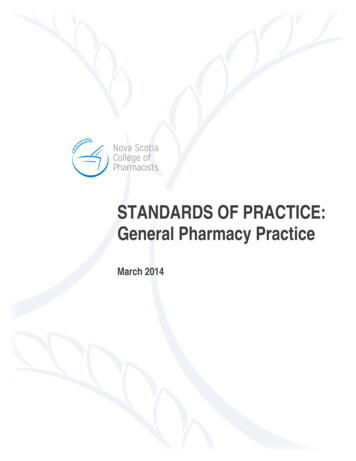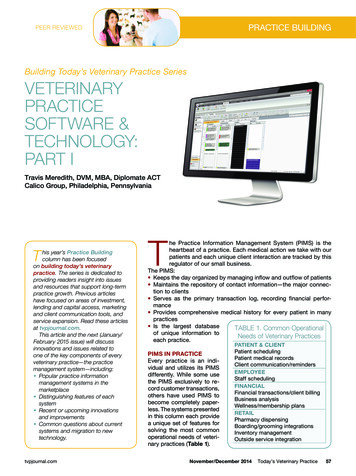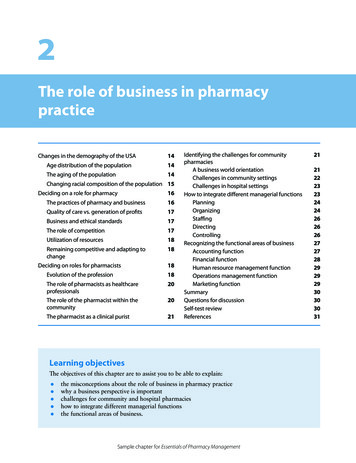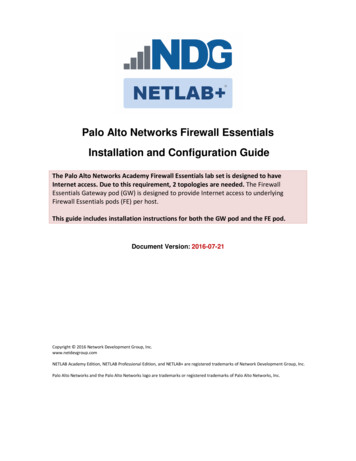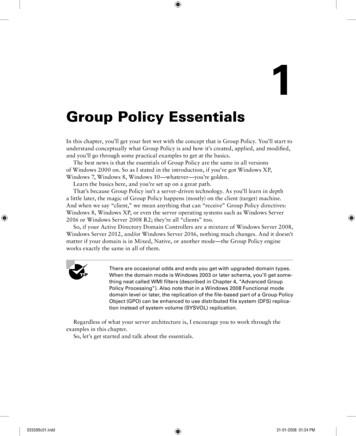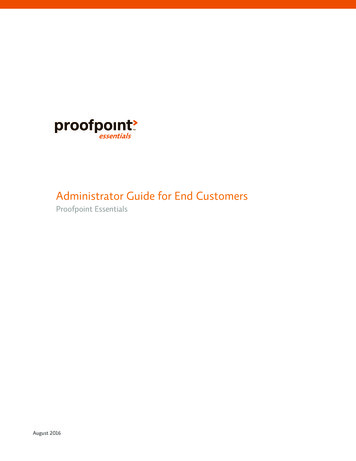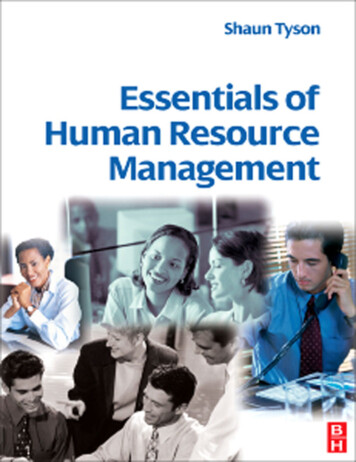
Transcription
PracticeEssentials
Practice EssentialsTable of ContentsPractice Requirements . 2Standards of Practice . 3Code of Ethics . 24Quality Assurance Program . 29Practice Guidelines. 38What you must know about college complaints . 39What you must know about communicating with patients . 43What you must know about Health Care Consent Act . 57What you must know about mandatory reporting . 69What you must know about performing procedures for medical radiation and imagingtechnologists. 78What you must know about professional accountability . 99What you must know about professional accountability of MRTs during a workstoppage . 117What you must know about professional liability insurance . 119Guidelines for determining whether MRTs require professional liability insurance . 123What you must know about professional misconduct . 129What you must know about sexual abuse . 135Legislation and Regulations . 139Medical Radiation and Imaging Technology Act, 2017 . 140Regulations under the Medical Radiation and Imaging Technology Act, 2017 . 140General (O. Reg. 375/12) . 140Registration (O. Reg. 866/93) . 140Professional Misconduct (O. Reg. 855/93) . 140Prescribed Forms of Energy (O. Reg. 226/03) . 140Regulations under the Regulated Health Professions Act. 140Controlled Acts (O. Reg. 107/96). 140CMRITO Practice Essentials 1
PracticeRequirementsCMRITO Practice Essentials 2
Standardsof Practice1CMRITO Standards of Practice 2020CMRITO Practice Essentials 3
Table of ContentsIntroduction11. Legislation, standards and ethics32. Equipment and materials43. Diagnostic and therapeutic procedures64. Safe practice115. Relationships with patients146. Professional relationships157. Records and reporting178. Continuing competence18CMRITO Standards of Practice 2020CMRITO Practice Essentials 4
IntroductionThe Standards of Practice have been developed by the College of Medical Radiationand Imaging Technologists of Ontario1 (CMRITO or the “College”) to describe theexpectations for professional practice of members of the College. The Standards ofPractice describe what each member is accountable and responsible for in practice.They represent performance criteria for members and can be used to interpret thescope of practice to the public and other health care professionals.In the Standards of Practice, “members” refers to all members of the CMRITO; that is,members in all of the five specialties: radiography, radiation therapy, nuclear medicine,magnetic resonance and diagnostic medical sonography. In the Standards of Practice,“profession” refers to the profession of medical radiation and imaging technology, whichincludes all of the five specialties: radiography, radiation therapy, nuclear medicine,magnetic resonance and diagnostic medical sonography.The Standards of Practice reflect the knowledge, skills and judgement that members needin order to perform the services and procedures that fall within the scope of practice of theprofession. The Regulated Health Professions Act and the companion health profession Acts govern thepractice of regulated health professions in Ontario. For this profession, the companion Act isthe Medical Radiation and Imaging Technology Act (MRIT Act). The Medical Radiation andImaging Technology Act sets out the scope of practice statement for the profession,as follows:“ The practice of medical radiation and imaging technology is the use of ionizingradiation, electromagnetism, soundwaves and other prescribed forms of energyfor the purposes of diagnostic or therapeutic procedures, the evaluation ofimages and data relating to the procedures and the assessment of an individualbefore, during and after the procedures.” The Medical Radiation and Imaging Technology Act also sets out which of the controlledacts as set out in the Regulated Health Professions Act, members are authorized to perform.These are known as authorized acts. The Medical Radiation and Imaging TechnologyAct states:On January 1, 2020, the Medical Radiation and Imaging Technology Act, 2017 (MRIT Act) came into force. The MRIT Actchanged the name of the College of Medical Radiation Technologists of Ontario to the College of Medical Radiation andImaging Technologists of Ontario, and the name of the profession to the medical radiation and imaging technology profession.1 1CMRITO Standards of Practice 2020CMRITO Practice Essentials 5
“ In the course of engaging in the practice of medical radiation and imagingtechnology, a member is authorized, subject to the terms, conditions andlimitations imposed on their certificate of registration, to perform the following:1. Administering substances by injection or inhalation.2. Tracheal suctioning of a tracheostomy.3. Administering contrast media, or putting an instrument, hand or finger, Beyond the opening of the urethra, Beyond the labia majora, Beyond the anal verge, or Into an artificial opening of the body.4. Performing a procedure on tissue below the dermis.5. Applying a prescribed form of energy.”The Standards of Practice are intended to be generic. The indicators that follow each PracticeStandard indicate the application of the Practice Standard in a specific dimension of practice.Most indicators refer to tasks that are common to all members. Indicators that refer to tasksgenerally performed only by members in one of the specialties are listed under separateheadings. The methods for implementing each task may be determined by departmentalpolicies and procedures.In the event that the Standards of Practice set a standard that is higher than departmentalpolicy or procedure, the member must comply with the standard set by the Standards ofPractice. In the Standards of Practice, the term “legislation” refers to both statutes andregulations.Under the College’s Standards of Practice, members of the College are expected to be: Competent: meaning to have the necessary knowledge, skills and judgement to performsafely, effectively and ethically and to apply that knowledge, skill and judgement to ensuresafe, effective and ethical outcomes for the patient. This means that members must maintaincompetence in their current area of practice, must refrain from acting if not competent, andmust take appropriate action to address the situation. Accountable: meaning to take responsibility for decisions and actions, including thoseundertaken independently and those undertaken as a member of a team. This means thatmembers must accept the consequences of their decisions and actions and act on thebasis of what they, in their clinical judgement, believe is in the best interests of the patient.2CMRITO Standards of Practice 2020CMRITO Practice Essentials 6
Members must take appropriate action if they feel these interests are being unnecessarily andunacceptably compromised. This includes not implementing ordered procedures or treatmentplans that, from their perspective, appear to be contraindicated, and in this event, takingappropriate action to address the situation. Collaborative: meaning to work with other members of the health care team to achievethe best possible outcomes for the patient. This means members are responsible forcommunicating and coordinating care provision with other members of the health careteam, and taking appropriate action to address gaps and differences in judgement aboutcare provision.1. Legislation, standards and ethicsIn order to be registered as a member of the College of Medical Radiation and ImagingTechnologists of Ontario, members must meet the professional education and otherregistration requirements set by the College. They must continue to educate themselvesabout practical, legal, ethical and other matters pertaining to the profession. Membersmust be competent, accountable and collaborative in their practice. Practice Standard: Members must understand, and adhere to, the legislation governing thepractice of the profession, the Standards of Practice set by the College, the Code of Ethicsand the by-laws of the College.IndicatorsMembers must:a. have the knowledge, skills and judgement to perform procedures undertaken in the courseof the practice of the professionb. take responsibility for decisions and actions, including those undertaken independentlyand those undertaken as a member of the teamc. work with other members of the health care team to achieve the best possible outcomesfor the patientd. adhere to all relevant provincial and federal legislation and guidelines governing thepractice of the professione. adhere to the Standards of Practice set by the Collegef.adhere to the Code of Ethics and the by-laws of the College3CMRITO Standards of Practice 2020CMRITO Practice Essentials 7
g. adhere to all regulations made under the Medical Radiation and Imaging Technology Actincluding: Quality AssuranceRegistrationProfessional MisconductAdvertising2. Equipment and materialsThe practice of members entails the use of a wide range of equipment and materials.Members must know and understand the functions, capabilities, specifications andhazards of the equipment and materials they use in the course of their practice. Practice Standard: Members must have the knowledge, skills and judgement to selectthe appropriate equipment and materials for procedures ordered by a physician or otherauthorized health professional, to make determinations as to the quality, serviceability andoperability of the equipment and materials, and to take any corrective actions required tomeet standards set by legislation, facility policies and manufacturers’ guidelines. Membersmust be skilled in making safe, efficient and effective use of resources to produce the desiredexamination information or deliver safe, effective treatment.IndicatorsMembers must:a. ensure the room is prepared for the procedure specified in the orderb. select and set up the equipment and materials needed for the procedure specifiedin the orderc. select the correct substances to be administered orally, by injection or inhalation, or intothe body through an orificed. prepare diagnostic or therapeutic substances as requirede. conduct the required quality control tests, or ensure that the required quality controltests have been conducted, on each piece of equipment and any materials used in theordered procedure, according to the applicable legislation and the facility policies andmanufacturers’ guidelines4CMRITO Standards of Practice 2020CMRITO Practice Essentials 8
f.ensure that the results of quality control tests are acceptableg. if quality control tests are not within acceptable limits, take corrective action to ensurethat the standards set by legislation, facility policies and manufacturers’ guidelinesare meth. determine the quality, serviceability, and operability of the equipment and materialsto be used in the procedure in accordance with the standards set by legislation, facilitypolicies and manufacturers’ guidelines, and if the standards are not met, takecorrective actioni.determine, set and verify the technique and protocol to be used in the procedurej.verify all required immobilization and/or beam modification devicesk. make use of appropriate shielding devicesIn addition, members in the specialty of radiation therapy must:l. prepare or construct immobilization or personalized devices and/or beam modificationdevices as requiredIn addition, members in the specialty of magnetic resonance must:m. administer and follow the necessary safety precautions for entry to the magnet roomIn addition, members in the specialty of nuclear medicine and radiation therapy must:n. dispose of expired, unused or contaminated eluate, radioactive materials and alladministrative devices in accordance with legislation and established safety protocolso. store radiopharmaceuticals and radioactive materials according to manufacturers’specificationsIn addition, members in the specialty of diagnostic medical sonography must:p. clean and/or reprocess transducers, or ensure that transducers are cleaned and/orreprocessed after each patient use in accordance with the manufacturers’ guidelines,other applicable guidelines and the facility policiesq. use, store and dispose of ultraso
CMRITO Practice Essentials 8. CMRITO Standards of Practice 2020 5. f. ensure that the results of quality control tests are acceptable g. if quality control tests are not within acceptable limits, take corrective action to ensure that the standards set by legislation, facility policies and manufacturers’ guidelines are met h. determine the quality, serviceability, and operability of the .
